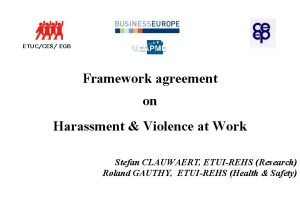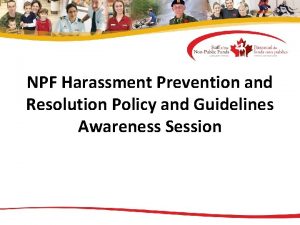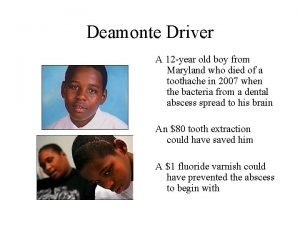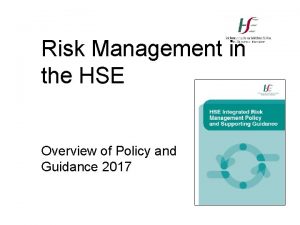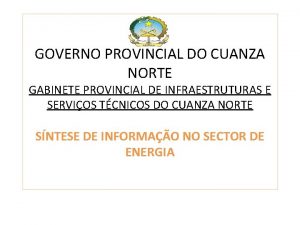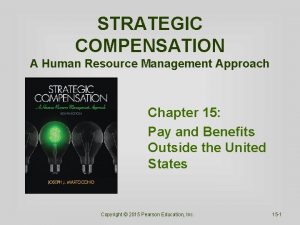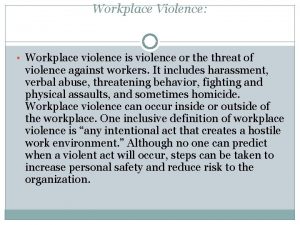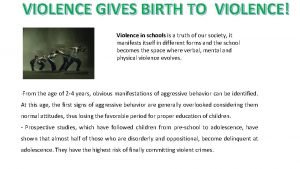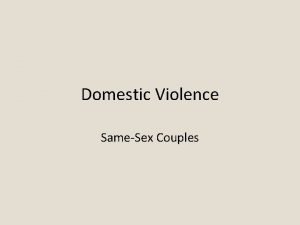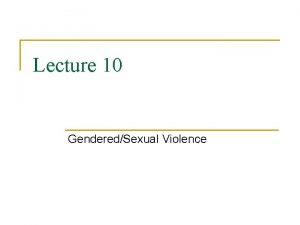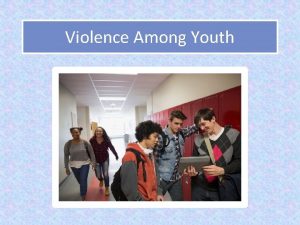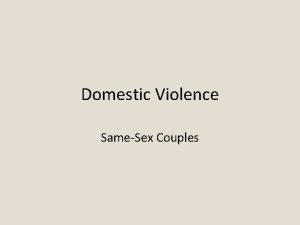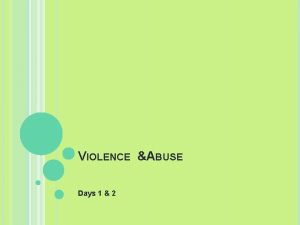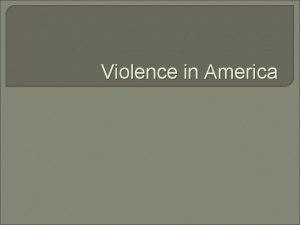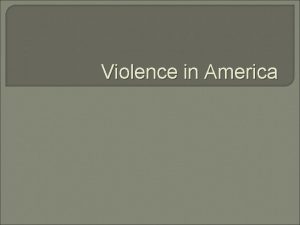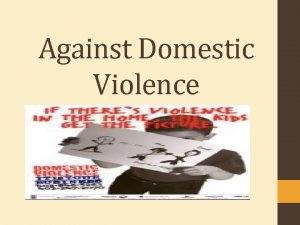INTEGRATED PROVINCIAL VIOLENCE PREVENTION POLICY FRAMEWORK SAVI WCG















- Slides: 15

INTEGRATED PROVINCIAL VIOLENCE PREVENTION POLICY FRAMEWORK SAVI/ WCG/ CHEC UNDERSTANDING AND PREVENTING VIOLENCE IN AFRICA COLLOQUIUM 2 NOVEMBER 2013

Background to Integrated Provincial Violence Prevention Policy Framework (IPVPP) • Every year, the WCG spends up to 80% of its health budget on preventable conditions, including injury-related deaths on our roads, and injuries and deaths from interpersonal violence fuelled by alcohol- and drug use. This places a massive burden on the public healthcare system, and drains precious resources which could otherwise be spent on improving the lives of the people of the province and providing healthcare to patients suffering from illnesses that are not preventable. • The costs of violence are not borne by the state alone. Violence devastates families. It destroys communities. And it rips apart the social fabric. Yet violence can be prevented if the state and society work together in a “whole-of-society” approach. • This means that state has a critical role to play in shaping the kind of socio-economic environment that discourages violence in the first place. By expanding opportunities to individuals, families and communities so that they can take control of their lives, the state reduces the likelihood of violence occurring. • Individuals also have a duty to prevent violence through the life choices they make, parents through the responsibility they take and the guidance they give, whole communities through the cultural and social norms they establish, and institutions like schools in the leadership they provide. © Western Cape Government 2012 |

Background to IPVPP • 2007 Burden of Disease (Bo. D) reduction project identified prevention of violence as a public health priority to be included among the provincial DOH’s five focus areas for prevention. • In September 2011, the Western Cape Government (WCG), through its Department of Health (DOH), hosted the 5 th Milestones meeting together with the World Health Organisation and the national DOH. • Milestones 5 emphasised the need for the WCG to put in place an integrated and intersectoral policy framework that sets out strategies for violence prevention, along with data-driven, evidence-based violence prevention programmes. • First draft of IPVPP led by Injury Prevention Working Group under SO 4: Increasing Wellness. • August 2013: Final version of the IPVPP adopted by Cabinet. © Western Cape Government 2012 |

Violence: the global picture • Claims 1. 6 million lives annually worldwide, or 4000 deaths per day. • 50 percent die by suicide, more than one third die by homicide, and roughly 10 percent die directly as a result of war or other form of collective violence. • Around 90 percent of deaths due to violence occur in low-income and middle -income countries. • Males account for 77 percent of all homicides. …………………. BUT……………. . VIOLENCE IS PREVENTABLE © Western Cape Government 2012 |

Violence in the Western Cape • 9162 deaths were recorded in the Western Cape catchment area from January to December 2010. Some 5466, or 60%, of these deaths were due to non-natural causes. The highest proportion of non-natural deaths were due to homicide (2264 deaths, or 41% of the total) and road deaths (1551 deaths, or 28%). • Violence accounts for 12. 9% of premature mortality and is the second leading cause of years of life lost (YLLs) after HIV/AIDS, which accounted for 14. 1% of YLLs in 2000. • Western Cape mortality rates are higher than national rates for males per hundred thousand (129 vs. 115), and females (25 vs. 21). • Homicide mortality rates in the Western Cape are 15% higher than in other provinces. • Interpersonal violence is the second leading cause of premature death in the province after HIV/Aids, and accounted for 42% of these deaths in 2008. • Injury is the second leading contributor to the Bo. D in the Western Cape, contributing nearly 20% to the overall Bo. D and claiming approximately 600 lives each month. • Among non-fatal injuries, interpersonal violence accounts for more than half of all injuries presenting to facilities in the state sector across all levels of care. © Western Cape Government 2012 |

Objectives • Enhance collaboration between the health, criminal justice, educational and social development sectors – and state and civil society – to prevent violence through the adoption of shared strategies. • Institutionalise an intersectoral framework that supports and sustains multi-dimensional prevention strategies over a long-term period. • Balance programmatic and policy interventions likely to reduce violence in the short term (e. g. by reducing access to alcohol) and interventions that affect sustained long-term change to the social environment and societal norms that support violence (e. g. by improving early childhood development and positive parenting). • Adopt an intervention approach driven by an accessible evidence base and reliable injury surveillance data. • Provide the framework for programmes and interventions to effect behaviour change – by incentivising behaviours that prevent violence, and disincentivising behaviours that promote violence. © Western Cape Government 2012 |

Risk factors for violence • Biological: Young males are more likely to be perpetrators and victims; Mental and physical impairment; Abuse and neglect in childhood affects brain development and negatively influences cognitive, psychological and social adjustment increasing the risk for violent and anti-social behaviour • Behavioural: Hyperactivity, impulsiveness, misconduct, and attention problems experienced in early childhood; Alcohol and substance abuse (between 27% and 47% of intentional injuries are related to the use of alcohol). • Socio-cultural: Families with a large number of children; mothers having children at a young age; low levels of family cohesion; single parent households; low socioeconomic status; abusive parental behaviour including harsh physical punishment and parental conflict; social exclusion; gangsterism; traditional gender and social norms supportive of violence associated with a man’s risk for abusing his partner. • Structural factors: Inequality; urbanisation; migration. © Western Cape Government 2012 |

Violence prevention strategies WHO recommends: • Developing safe, stable and nurturing relationships between children and their parents and caregivers; • Developing life skills – for example, social, emotional and behavioural competencies – in children and adolescents; • Reducing the availability and harmful use of alcohol; • Reducing access to lethal means, including guns, knives and pesticides; • Promoting gender equality to prevent violence against women; • Changing cultural and social norms that support violence; • Identifying victims and providing care and support programmes. © Western Cape Government 2012 |

Violence prevention strategies What is required is a comprehensive intersectoral approach that balances short-term interventions, focused initially on reducing access to alcohol, with longer term interventions to address the complex societal causes of violence more holistically. © Western Cape Government 2012 |

Reducing availability and harmful use of alcohol • Western Cape Liquor Act (2009) and High Street model • Selected high-risk area interventions in Khayelitsha, Nyanga, Elsies River, Hout Bay and *Khayamandi*: Ø Surveillance of injury cases presenting to health facilities serving these areas to inform prevention efforts; Ø A situational analysis to assess current violence prevention and specifically alcohol-related violence prevention activities and to explore opportunities for enhancement of these activities; and Ø Collaborative alcohol-related violence prevention activities between government and non-governmental agencies in these five areas. © Western Cape Government 2012 |

Developing safe, stable and nurturing relationships between children and their parents and caregivers • Interventions to prevent life-long negative consequences of child maltreatment for mental and physical health, social and occupational functioning, human capital and security and, ultimately, social and economic development. • Emerging evidence that such interventions reduce convictions and violent acts in adolescence and early adulthood, and probably help decrease intimate partner violence and self-directed violence in later life. • Homevisiting programmes, in which trained personnel visit parents and children in their homes and provide health advice, support, child development education and life coaching for parents to improve child health, foster parental care-giving abilities and prevent child maltreatment • Parenting education programmes, such as the Triple P, are usually centre-based and delivered in groups and aim to prevent child maltreatment by improving parents’ child-rearing skills, increasing parental knowledge of child development and encouraging positive child management strategies. © Western Cape Government 2012 |

Developing life skills in children and adolescents • Evidence shows that the life-skills acquired in social development programmes (which are aimed at building social, emotional and behavioural competencies) can prevent youth violence. • Life skills programmes that target children early in life can prevent aggression, reduce involvement in violence, improve social skills, boost educational achievement and improve job prospects. • MOD Centres • WC Early Childhood Development Strategy © Western Cape Government 2012 |

Promoting gender equality and changing cultural and social norms that support violence • School-based programmes can address gender norms and attitudes before they become deeply engrained in children and youth. • Programmes that combine microfinance with gender equity training can reduce intimate partner violence. • Programmes targeting youth violence and education through entertainment (“edutainment”) aimed at reducing intimate partner violence – Safety Lab in Nyanga. • Need for WCG to design and implement programmes that (i) seek to change the mindsets of abusers and potential abusers, in order to deal with the root causes of gender-based violence, and (ii) effect behaviour change – by incentivising socially responsible behaviours that prevent violence, and disincentivising socially irresponsible behaviours that promote violence. © Western Cape Government 2012 |

Conclusion • The successful implementation of all of these strategies, and their associated interventions – both short-term and long-term – requires the co-operation of all role-players in the public health and criminal justice sectors (and the social development sector, as well as and the active participation and partnership of citizens and civil society more broadly). • The role of active, responsible citizens, families and communities partnering with the state in a “whole-of-society” drive to prevent violence is critical. Violence prevention is not the sole preserve of the state. Nor does it serve the interests of social justice for the state to use its strained resources to mop up the consequences of violence – in the public healthcare system and elsewhere – when that violence could have been prevented in the first place. © Western Cape Government 2012 |

Thank you
 Primary prevention secondary prevention tertiary prevention
Primary prevention secondary prevention tertiary prevention Washington college grant
Washington college grant Savi nea
Savi nea Referat o svetom savi
Referat o svetom savi Executive summary of salon
Executive summary of salon Modality
Modality Framework agreement on harassment and violence at work
Framework agreement on harassment and violence at work Policy on harassment prevention and resolution
Policy on harassment prevention and resolution Nancy milio framework for prevention
Nancy milio framework for prevention Risk management policy hse
Risk management policy hse E commerce security meaning
E commerce security meaning Integrated maritime policy
Integrated maritime policy Provincial achievement tests
Provincial achievement tests Governo provincial do cuanza norte
Governo provincial do cuanza norte Alberta provincial logbook rules
Alberta provincial logbook rules Provincial salary rate
Provincial salary rate






